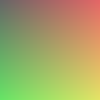| Name | colorMode() |
||||||||||||
|---|---|---|---|---|---|---|---|---|---|---|---|---|---|
| Examples |

noStroke()
colorMode(RGB, 100)
for i in range(100):
for j in range(100):
stroke(i, j, 0)
point(i, j)

noStroke()
colorMode(HSB, 100)
for i in range(100):
for j in range(100):
stroke(i, j, 100)
point(i, j)
# If the color is defined here, it won't be
# affected by the colorMode() in setup().
# Instead, just declare the variable here and
# assign the value after the colorMode() in setup()
#bg = color(180, 50, 50) # No
def setup():
size(100, 100)
colorMode(HSB, 360, 100, 100)
global bg
bg = color(180, 50, 50)
def draw():
background(bg)
| ||||||||||||
| Description | Changes the way Processing interprets color data. By default, the parameters for fill(), stroke(), background(), and color() are defined by values between 0 and 255 using the RGB color model. The colorMode() function is used to change the numerical range used for specifying colors and to switch color systems. For example, calling colorMode(RGB, 1.0) will specify that values are specified between 0 and 1. The limits for defining colors are altered by setting the parameters max, max1, max2, max3, and maxA. | ||||||||||||
| Syntax | colorMode(mode) colorMode(mode, max) colorMode(mode, max1, max2, max3) colorMode(mode, max1, max2, max3, maxA) | ||||||||||||
| Parameters |
| ||||||||||||
| Related |
background() fill() stroke() |
Updated on Tue Feb 27 14:07:12 2024.
If you see any errors or have comments, please let us know.

This work is licensed under a Creative Commons Attribution-NonCommercial-ShareAlike 4.0 International License